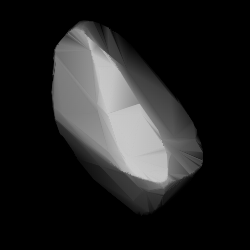Background asteroid
1119 Euboea (; prov. designation 1927 UB ) is a background asteroid from the central region of the asteroid belt . It was discovered on 27 October 1927, by German astronomer Karl Reinmuth at the Heidelberg-Königstuhl State Observatory in southwest Germany.[ 3] rotation period of 11.4 hours and measures approximately 30 kilometers (19 miles) in diameter. It was named for the Greek island of Euboea .[ 2]
Orbit and classification
Euboea is a non-family asteroid of the main belt's background population when applying the hierarchical clustering method to its proper orbital elements .[ 4] [ 5] central asteroid belt at a distance of 2.2–3.0 AU once every 4 years and 3 months (1,540 days; semi-major axis of 2.61 AU). Its orbit has an eccentricity of 0.16 and an inclination of 8° with respect to the ecliptic .[ 1] observation arc begins with a recovered observation from the Lowell Observatory in April 1930, more than 2 years after to its official discovery observation.[ 3]
Naming
This minor planet was named after Euboea , also known as "Negropont", the largest island of Greece in the Aegean Sea . The naming was mentioned in The Names of the Minor Planets Paul Herget in 1955 (H 105 [ 2]
Physical characteristics
Euboea is an assumed stony S-type asteroid .[ 9]
Rotation period and poles
In October 2007, a first rotational lightcurve of Euboea was obtained from photometric observations by astronomers at the Oakley Southern Sky Observatory in Australia. Lightcurve analysis gave a rotation period of 11.41 hours with a brightness variation of 0.50 magnitude (U=3 [ 15] Pierre Antonini (U=3 [ 12]
In 2016, two modeled lightcurves were published using photometric data from the Lowell Photometric Database and other sources. They gave a concurring sidereal period of 11.3981 and 11.39823 hours, respectively.[ 13] [ 14] spin axes of (79.0°, 75.0°) and (282.0°, 55.0°),[ 13] [ 14] ecliptic coordinates (λ, β).
Diameter and albedo
According to the surveys carried out by the Japanese Akari satellite and the NEOWISE mission of NASA's Wide-field Infrared Survey Explorer , Euboea measures between 18.37 and 31.90 kilometers in diameter and its surface has an albedo between 0.0576 and 0.213.[ 6] [ 7] [ 8] [ 10] [ 11] Collaborative Asteroid Lightcurve Link derives a low albedo of 0.0539 – typical for carbonaceous C-type asteroids – and a diameter of 31.46 kilometers based on an absolute magnitude of 11.3.[ 9]
References
^ a b c d e "JPL Small-Body Database Browser: 1119 Euboea (1927 UB)" (2017-12-01 last obs.). Jet Propulsion Laboratory. Retrieved 25 January 2018 .^ a b c Schmadel, Lutz D. (2007). "(1119) Euboea". Dictionary of Minor Planet Names . Springer Berlin Heidelberg. p. 95. doi :10.1007/978-3-540-29925-7_1120 . ISBN 978-3-540-00238-3 ^ a b c "1119 Euboea (1927 UB)" . Minor Planet Center . Retrieved 25 January 2018 .^ a b "Asteroid 1119 Euboea – Proper Elements" . AstDyS-2, Asteroids – Dynamic Site. Retrieved 28 October 2019 .^ a b "Asteroid 1119 Euboea" . Small Bodies Data Ferret . Retrieved 13 March 2020 .^ a b c d Nugent, C. R.; Mainzer, A.; Bauer, J.; Cutri, R. M.; Kramer, E. A.; Grav, T.; et al. (September 2016). "NEOWISE Reactivation Mission Year Two: Asteroid Diameters and Albedos" . The Astronomical Journal . 152 (3): 12. arXiv :1606.08923 Bibcode :2016AJ....152...63N . doi :10.3847/0004-6256/152/3/63 ^ a b c d Nugent, C. R.; Mainzer, A.; Masiero, J.; Bauer, J.; Cutri, R. M.; Grav, T.; et al. (December 2015). "NEOWISE Reactivation Mission Year One: Preliminary Asteroid Diameters and Albedos". The Astrophysical Journal . 814 (2): 13. arXiv :1509.02522 Bibcode :2015ApJ...814..117N . doi :10.1088/0004-637X/814/2/117 . S2CID 9341381 . ^ a b c Masiero, Joseph R.; Grav, T.; Mainzer, A. K.; Nugent, C. R.; Bauer, J. M.; Stevenson, R.; et al. (August 2014). "Main-belt Asteroids with WISE/NEOWISE: Near-infrared Albedos". The Astrophysical Journal . 791 (2): 11. arXiv :1406.6645 Bibcode :2014ApJ...791..121M . doi :10.1088/0004-637X/791/2/121 . S2CID 119293330 . ^ a b c d e f "LCDB Data for (1119) Euboea" . Asteroid Lightcurve Database (LCDB). Retrieved 25 January 2018 .^ a b c d Mainzer, A.; Grav, T.; Masiero, J.; Hand, E.; Bauer, J.; Tholen, D.; et al. (November 2011). "NEOWISE Studies of Spectrophotometrically Classified Asteroids: Preliminary Results". The Astrophysical Journal . 741 (2): 25. arXiv :1109.6407 Bibcode :2011ApJ...741...90M . doi :10.1088/0004-637X/741/2/90 . S2CID 35447010 . ^ a b c d Usui, Fumihiko; Kuroda, Daisuke; Müller, Thomas G.; Hasegawa, Sunao; Ishiguro, Masateru; Ootsubo, Takafumi; et al. (October 2011). "Asteroid Catalog Using Akari: AKARI/IRC Mid-Infrared Asteroid Survey" . Publications of the Astronomical Society of Japan . 63 (5): 1117– 1138. Bibcode :2011PASJ...63.1117U . doi :10.1093/pasj/63.5.1117 online , AcuA catalog p. 153 )^ a b Behrend, Raoul. "Asteroids and comets rotation curves – (1119) Euboea" . Geneva Observatory. Retrieved 25 January 2018 . ^ a b c Hanuš, J.; Ďurech, J.; Oszkiewicz, D. A.; Behrend, R.; Carry, B.; Delbo, M.; et al. (February 2016). "New and updated convex shape models of asteroids based on optical data from a large collaboration network". Astronomy and Astrophysics . 586 : A108. arXiv :1510.07422 Bibcode :2016A&A...586A.108H . doi :10.1051/0004-6361/201527441 . ISSN 0004-6361 . S2CID 119112278 . ^ a b c Durech, J.; Hanus, J.; Oszkiewicz, D.; Vanco, R. (March 2016). "Asteroid models from the Lowell photometric database". Astronomy and Astrophysics . 587 : 6. arXiv :1601.02909 Bibcode :2016A&A...587A..48D . doi :10.1051/0004-6361/201527573 . S2CID 118427201 . ^ a b Torno, Steven; Oliver, Robert Lemke; Ditteon, Richard (June 2008). "Asteroid Lightcurve Analysis at the Oakley Southern Sky Observatory - October 2007" (PDF) . Minor Planet Bulletin . 35 (2): 54– 55. Bibcode :2008MPBu...35...54T . ISSN 1052-8091 .
External links
